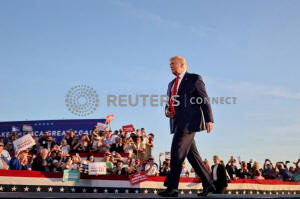Supporters who helped Trump win presidency lagging in motivation this
year
 Send a link to a friend
Send a link to a friend
 [September 08, 2020]
By Chris Kahn [September 08, 2020]
By Chris Kahn
NEW YORK (Reuters) - With less than two
months to go until the U.S. election, President Donald Trump is having
trouble energizing his core supporters, especially white voters without
college degrees who were key to his victory in 2016, a Reuters polling
analysis shows.
The analysis, based on Reuters/Ipsos national opinion polling from May
to August and 2016 exit poll data, found that Trump has lost support
among non-college educated whites, who made up 44% of the U.S.
electorate four years ago and heavily favored the Republican over
Democrat Hillary Clinton.
Trump is still more popular with this group than Democratic presidential
nominee Joe Biden, with 46% saying they would vote for Trump, compared
with 34% who back Biden. But his 12-point advantage in August is down
from a 21-point lead in May, and well below the 34-point advantage he
had over Clinton. https://tmsnrt.rs/2ZajmYu
What is more worrisome for Trump, however, is that the constituency's
commitment to voting has remained flat this year, while interest has
risen among groups that lean toward Democrats: minorities, women, urban
and suburban residents and people with below-average incomes.

The data suggests that this time, there will be greater pressure on the
Republican Party - and not the Democratic Party - to boost voter turnout
to win.
"This is rare, and it’s an interesting indication of how energized or
agitated the electorate is," said Donald Green, a political scientist at
Columbia University. "People who would ordinarily not make it past the
likely voter screen are doing so because they're so decisively hostile
toward the president."
In the August poll, 69% of registered African-American voters and 61% of
registered Hispanic voters said they were “certain” to cast their
ballots in November, up 7 and 6 percentage points, respectively, from
May. The number of committed voters rose by 5 points each among women,
suburban and urban residents, and people who make less than $50,000 a
year.
The number of certain voters has remained unchanged among non-college
whites since May at 65%, and is down 2 points among rural Americans to
63%.
The number of registered Democrats who say they are “certain” to vote
has increased by about 5 percentage points to 79% from May to August,
while it has increased by 1 point among registered Republicans to 78%,
the polling shows. That's a reversal from August 2016, when 69% of
registered Democrats and 71% of registered Republicans said they were
certain to vote. https://tmsnrt.rs/3jPvUfR
An Ipsos analysis of the data shows that Biden leads Trump by 10
percentage points in election scenarios that include only the most
engaged, or "likely," voters. Trump claws back most of Biden’s advantage
only in high-turnout scenarios.
The Republican Party has traditionally attracted the most politically
active Americans, including majorities of older, white voters, religious
conservatives and gun owners.
Republican candidates usually could expect to perform better in
elections where the turnout was low.
[to top of second column]
|

President Donald Trump holds a campaign rally in Londonderry, New
Hampshire, U.S., August 28, 2020. REUTERS/Carlos Barria

To be sure, Trump’s base is likely to get more fired up the closer
it gets to Election Day. The August polling shows as many as 20% of
white voters without college degrees remain undecided. In 2016,
about one in every eight Trump voters said they made their choice in
the last week of the campaign, according to a Reuters/Ipsos poll at
the time.
TROUBLE WITH THE WHITE BASE
Despite the growth of minority populations, whites still dominate
the U.S. electorate, accounting for nearly three-quarters of the
voters in 2016, even though they make up only 60% of the overall
population.
Their opinions are crucial for Trump, who during his presidency has
focused on opposing immigration and expressed his sympathy for white
racial grievances. Trump has criticized anti-racism protesters as
"thugs," and most recently defended a white gunman charged with
killing two Black Lives Matter demonstrators in Wisconsin.
According to Reuters/Ipsos polling in August, 61% of non-college
whites believe the country is headed in the wrong direction, and 53%
think the same of the U.S. economy. More than 70% say they are
concerned about the coronavirus pandemic, and only 48% approve of
the way Trump has responded to the crisis.
Meanwhile, 48% of college-educated whites said they would support
Biden and 40% said they would back Trump. This compares with exit
polls in 2016 that showed Clinton had just a 2-point edge over Trump
with the same group.
Trump campaign spokesman Hogan Gidley said its internal polling
shows that the president is "tied or ahead in all of the key
battleground states."
"Our data shows supporters are wildly enthusiastic and excited to
cast their vote for the President, unlike the small minority of
Democrats who actually like Joe Biden," Gidley said.
Polls by media and academic organizations currently show Biden ahead
by at least a few points in most battleground states, including
Wisconsin, Michigan, Pennsylvania, Florida and Arizona, however.
Trump's efforts to discourage voting by mail due to the coronavirus
pandemic - saying without evidence that it will lead to widespread
fraud - may backfire given that the data suggests a higher turnout
would work in his favor.

"Some people are going to be discouraged, some people are going to
motivated to push back and vote, and some will be confused about
what to do," said Myrna Perez, the director of the Voting Rights and
Elections Program at the Brennan Center for Justice.
(Reporting by Chris Kahn, Editing by Soyoung Kim and Sonya
Hepinstall)
[© 2020 Thomson Reuters. All rights
reserved.] Copyright 2020 Reuters. All rights reserved. This material may not be published,
broadcast, rewritten or redistributed.
Thompson Reuters is solely responsible for this content. |